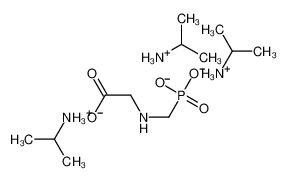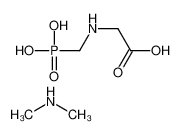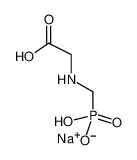| Product name | Glyphosate |
|---|
| Product number | - |
|---|---|
| Other names | N-(phosphonomethyl)glycine |
| Identified uses | For industry use only. Herbicide |
|---|---|
| Uses advised against | no data available |
| Company | MOLBASE (Shanghai) Biotechnology Co., Ltd. |
|---|---|
| Address | Floor 4 & 5, Building 12, No. 1001 North Qinzhou Road, Xuhui District, Shanghai, China |
| Telephone | +86(21)64956998 |
| Fax | +86(21)54365166 |
| Emergency phone number | +86-400-6021-666 |
|---|---|
| Service hours | Monday to Friday, 9am-5pm (Standard time zone: UTC/GMT +8 hours). |
Serious eye damage, Category 1
Hazardous to the aquatic environment, long-term (Chronic) - Category Chronic 2
2.2 GHS label elements, including precautionary statements| Pictogram(s) |   |
|---|---|
| Signal word | Danger |
| Hazard statement(s) | H318 Causes serious eye damage H411 Toxic to aquatic life with long lasting effects |
| Precautionary statement(s) | |
| Prevention | P280 Wear protective gloves/protective clothing/eye protection/face protection. P273 Avoid release to the environment. |
| Response | P305+P351+P338 IF IN EYES: Rinse cautiously with water for several minutes. Remove contact lenses, if present and easy to do. Continue rinsing. P310 Immediately call a POISON CENTER/doctor/… P391 Collect spillage. |
| Storage | none |
| Disposal | P501 Dispose of contents/container to ... |
none
3.Composition/information on ingredients 3.1 Substances| Chemical name | Common names and synonyms | CAS number | EC number | Concentration |
|---|---|---|---|---|
| Glyphosate | Glyphosate | 1071-83-6 | none | 100% |
Consult a physician. Show this safety data sheet to the doctor in attendance.
If inhaledFresh air, rest.
In case of skin contactRemove contaminated clothes. Rinse and then wash skin with water and soap.
In case of eye contactFirst rinse with plenty of water for several minutes (remove contact lenses if easily possible), then refer for medical attention.
If swallowedRinse mouth. Do NOT induce vomiting.
4.2 Most important symptoms/effects, acute and delayedSYMPTOMS: Symptoms of exposure to this compound include irritation of the skin, gastrointestinal tract and respiratory tract, convulsions and coma. It may also cause enhanced breathing. ACUTE/CHRONIC HAZARDS: This compound is an irritant of the skin, respiratory tract and gastrointestinal tract. When heated to decomposition it emits very toxic fumes of nitrogen oxides and phosphorus oxides.
4.3 Indication of immediate medical attention and special treatment needed, if necessaryImmediate first aid: Ensure that adequate decontamination has been carried out. If patient is not breathing, start artificial respiration, preferably with a demand-valve resuscitator, bag-valve-mask device, or pocket mask, as trained. Perform CPR as necessary. Immediately flush contaminated eyes with gently flowing water. Do not induce vomiting. If vomiting occurs, lean patient forward or place on left side (head-down position, if possible) to maintain an open airway and prevent aspiration. Keep patient quiet and maintain normal body temperature. Obtain medical attention. /Glyphosate (Roundup) and Related Compounds/
5.Fire-fighting measures 5.1 Extinguishing media Suitable extinguishing media/To fight fire use/ powder, alcohol-resistant foam, water spray, carbon dioxide.
5.2 Specific hazards arising from the chemicalFlash point data for this chemical are not available; however, it is probably combustible.
5.3 Special protective actions for fire-fightersWear self-contained breathing apparatus for firefighting if necessary.
6.Accidental release measures 6.1 Personal precautions, protective equipment and emergency proceduresUse personal protective equipment. Avoid dust formation. Avoid breathing vapours, mist or gas. Ensure adequate ventilation. Evacuate personnel to safe areas. Avoid breathing dust. For personal protection see section 8.
6.2 Environmental precautionsPersonal protection: particulate filter respirator adapted to the airborne concentration of the substance. Do NOT let this chemical enter the environment. Sweep spilled substance into covered plastic containers. If appropriate, moisten first to prevent dusting. Carefully collect remainder. Then store and dispose of according to local regulations.
6.3 Methods and materials for containment and cleaning upSweep spilled substance into plastic containers; if appropriate, moisten first to prevent dusting. Carefully collect remainder, then remove to safe place. Do NOT let this chemical enter the environment.
7.Handling and storage 7.1 Precautions for safe handlingAvoid contact with skin and eyes. Avoid formation of dust and aerosols. Avoid exposure - obtain special instructions before use.Provide appropriate exhaust ventilation at places where dust is formed. For precautions see section 2.2.
7.2 Conditions for safe storage, including any incompatibilitiesProvision to contain effluent from fire extinguishing. Separated from food and feedstuffs. Well closed. Do NOT store or transport in containers made from galvanized steel or unlined steel. Store in an area without drain or sewer access.Safe Storage of Pesticides. Always store pesticides in their original containers, complete with labels that list ingredients, directions for use, and first aid steps in case of accidental poisoning. Never store pesticides in cabinets with or near food, animal feed, or medical supplies. Do not store pesticides in places where flooding is possible or in places where they might spill or leak into wells, drains, ground water, or surface water.
8.Exposure controls/personal protection 8.1 Control parameters Occupational Exposure limit valuesno data available
Biological limit valuesno data available
8.2 Appropriate engineering controlsHandle in accordance with good industrial hygiene and safety practice. Wash hands before breaks and at the end of workday.
8.3 Individual protection measures, such as personal protective equipment (PPE) Eye/face protectionSafety glasses with side-shields conforming to EN166. Use equipment for eye protection tested and approved under appropriate government standards such as NIOSH (US) or EN 166(EU).
Skin protectionWear impervious clothing. The type of protective equipment must be selected according to the concentration and amount of the dangerous substance at the specific workplace. Handle with gloves. Gloves must be inspected prior to use. Use proper glove removal technique(without touching glove's outer surface) to avoid skin contact with this product. Dispose of contaminated gloves after use in accordance with applicable laws and good laboratory practices. Wash and dry hands. The selected protective gloves have to satisfy the specifications of EU Directive 89/686/EEC and the standard EN 374 derived from it.
Respiratory protectionWear dust mask when handling large quantities.
Thermal hazardsno data available
9.Physical and chemical properties| Physical state | white powder |
|---|---|
| Colour | White crystals |
| Odour | Odorless |
| Melting point/ freezing point | 230ºC |
| Boiling point or initial boiling point and boiling range | 465.8ºC at 760 mmHg |
| Flammability | Combustible. Gives off irritating or toxic fumes (or gases) in a fire. |
| Lower and upper explosion limit / flammability limit | no data available |
| Flash point | 235.5ºC |
| Auto-ignition temperature | no data available |
| Decomposition temperature | <234°C |
| pH | no data available |
| Kinematic viscosity | no data available |
| Solubility | In water:1.2 g/100 mL |
| Partition coefficient n-octanol/water (log value) | no data available |
| Vapour pressure | 1.94e-07 mm Hg at 45°C |
| Density and/or relative density | 1.74 |
| Relative vapour density | no data available |
| Particle characteristics | no data available |
no data available
10.2 Chemical stabilityNegligible volatility
10.3 Possibility of hazardous reactionsDust explosion possible if in powder or granular form, mixed with air. If dry, it can be charged electrostatically by swirling, pneumatic transport, pouring, etc.GLYPHOSATE may react with galvanized steel or unlined steel (except stainless steel) containers to produce hydrogen gas which may form a highly combustible or explosive gas mixture. It can react with caustic (basic) materials to liberate heat. It is corrosive to iron.
10.4 Conditions to avoidno data available
10.5 Incompatible materialsIncompatible materials: Strong oxidizing agents, metals, bases.
10.6 Hazardous decomposition productsWhen heated to decomposition it emits very toxic fumes of /nitrogen and phosphorus oxides/.
11.Toxicological information Acute toxicity- Oral: LD50 Goat oral 3530 mg/kg
- Inhalation: LC50 Rat inhalation >4.98 mg/L air/4 hr
- Dermal: LD50 Rabbit percutaneous >5000 mg/kg
no data available
Serious eye damage/irritationno data available
Respiratory or skin sensitizationno data available
Germ cell mutagenicityno data available
CarcinogenicityClassification - D; not classifiable as to human carcinogenicity. Basis - Inadequate evidence for oncogenicity in animals. Glyphosate was originally classified as C, possible human carcinogen, on the basis of increased incidence of renal tumors in mice. Following independent review of the slides the classification was changed to D on the basis of a lack of statistical significance and uncertainty as to a treatment-related effect.
Reproductive toxicityno data available
STOT-single exposureno data available
STOT-repeated exposureno data available
Aspiration hazardno data available
12.Ecological information 12.1 Toxicity- Toxicity to fish: LC50; Species: /Oncorhynchus mykiss/ (Rainbow trout) weight 0.8 g; Conditions: static bioassay without aeration, 12°C, pH 7.2-7.5, water hardness 40-50 mg/L as calcium carbonate and alkalinity of 30-35 mg/L Concentration: 130 mg/L for 96 hr (95% confidence interval: 108-156 mg/L) /Technical material, 96.7%
- Toxicity to daphnia and other aquatic invertebrates: EC50; Species: Daphnia magna (Water Flea) age <24 hr; Conditions: freshwater, static; Concentration: >22000 ug/L for 48 hr; Effect: intoxication, immobilization /80% purity
- Toxicity to algae: EC50; Species: Microcystis aeruginosa (Blue-Green Algae) Exponential Growth Phase; Conditions: freshwater, static, 22°C; Concentration: 251400 ug/L for 21 days; Effect: decreased population growth rate /formulation
- Toxicity to microorganisms: no data available
AEROBIC: When glyphosate was incubated in Williams silt loam soil (pH 6.4, 1.9% organic matter), 19% degradation occurred in 9 days. No degradation was noted in sterilized soil(1). In shake-flask metabolism studies, glyphosate was rapidly and completely biodegraded in the presence of soil microorganisms under both aerobic and anaerobic conditions(2). After 28 days under aerobic conditions, 45-55% of the glyphosate was mineralized using Ray silt loam soil, Lintonia sandy loam soil, and Drummer silty clay loam soil. Norfolk sandy loam mineralized glyphosate at a much slower, but still significant, rate. In greenhouse experiments, the half-lives of glyphosate in Ray, Drummer and Norfolk soil was 3, 27, and 130 days, respectively(2). The biodegradation half-life of glyphosate in a Kickapoo sandy loam and Dupo silt loam soil were 1.85 and 2.06 days, respectively, under aerobic conditions. The major degradation product observed was aminomethyl phosphonic acid. The aerobic and anaerobic biodegradation half-life of glyphosate in a flooded silty clay loam sediment was 7 and 8.1 days, respectively(3).
12.3 Bioaccumulative potentialIn controlled laboratory studies using glyphosate at levels 3 to 4 times the recommended application rates, BCF values in fish tissue 10-14 days post application ranged from 0.2 to 0.3(1). A BCF value of 0.52 (whole body) was measured in bluegill (Lepomis macrochirus) exposed for 28 days(2). BCF values of 0.38 for edible tissues and 0.63 for non-edible tissues have been reported(3). According to a classification scheme(4), these BCF data suggest that bioconcentration in aquatic organisms is low(SRC).
12.4 Mobility in soilWhen applied to clay loam or muck soil at an application rate of 56 kg/ha, glyphosate was rapidly inactivated. This inactivation was probably the result of reversible adsorption to clay and organic matter. Iron and aluminum clays and organic matter adsorbed more glyphosate than sodium and calcium clays and was readily bound to kaolinite, illite, bentonite, charcoal and muck but not to ethyl cellulose. (14)C-Labeled glyphosate was degraded in soil and (14)CO2 was released.
12.5 Other adverse effectsno data available
13.Disposal considerations 13.1 Disposal methods ProductThe material can be disposed of by removal to a licensed chemical destruction plant or by controlled incineration with flue gas scrubbing. Do not contaminate water, foodstuffs, feed or seed by storage or disposal. Do not discharge to sewer systems.
Contaminated packagingContainers can be triply rinsed (or equivalent) and offered for recycling or reconditioning. Alternatively, the packaging can be punctured to make it unusable for other purposes and then be disposed of in a sanitary landfill. Controlled incineration with flue gas scrubbing is possible for combustible packaging materials.
14.Transport information 14.1 UN Number| ADR/RID: UN3077 | IMDG: UN3077 | IATA: UN3077 |
| ADR/RID: ENVIRONMENTALLY HAZARDOUS SUBSTANCE, SOLID, N.O.S. |
| IMDG: ENVIRONMENTALLY HAZARDOUS SUBSTANCE, SOLID, N.O.S. |
| IATA: ENVIRONMENTALLY HAZARDOUS SUBSTANCE, SOLID, N.O.S. |
| ADR/RID: 9 | IMDG: 9 | IATA: 9 |
| ADR/RID: III | IMDG: III | IATA: III |
| ADR/RID: yes | IMDG: yes | IATA: yes |
no data available
14.7 Transport in bulk according to Annex II of MARPOL 73/78 and the IBC Codeno data available
15.Regulatory information 15.1 Safety, health and environmental regulations specific for the product in question| Chemical name | Common names and synonyms | CAS number | EC number |
|---|---|---|---|
| Glyphosate | Glyphosate | 1071-83-6 | none |
| European Inventory of Existing Commercial Chemical Substances (EINECS) | Listed. | ||
| EC Inventory | Listed. | ||
| United States Toxic Substances Control Act (TSCA) Inventory | Not Listed. | ||
| China Catalog of Hazardous chemicals 2015 | Not Listed. | ||
| New Zealand Inventory of Chemicals (NZIoC) | Listed. | ||
| Philippines Inventory of Chemicals and Chemical Substances (PICCS) | Listed. | ||
| Vietnam National Chemical Inventory | Listed. | ||
| Chinese Chemical Inventory of Existing Chemical Substances (China IECSC) | Listed. | ||
| Creation Date | Aug 12, 2017 |
|---|---|
| Revision Date | Aug 12, 2017 |
- CAS: Chemical Abstracts Service
- ADR: European Agreement concerning the International Carriage of Dangerous Goods by Road
- RID: Regulation concerning the International Carriage of Dangerous Goods by Rail
- IMDG: International Maritime Dangerous Goods
- IATA: International Air Transportation Association
- TWA: Time Weighted Average
- STEL: Short term exposure limit
- LC50: Lethal Concentration 50%
- LD50: Lethal Dose 50%
- EC50: Effective Concentration 50%
- IPCS - The International Chemical Safety Cards (ICSC), website: http://www.ilo.org/dyn/icsc/showcard.home
- HSDB - Hazardous Substances Data Bank, website: https://toxnet.nlm.nih.gov/newtoxnet/hsdb.htm
- IARC - International Agency for Research on Cancer, website: http://www.iarc.fr/
- eChemPortal - The Global Portal to Information on Chemical Substances by OECD, website: http://www.echemportal.org/echemportal/index?pageID=0&request_locale=en
- CAMEO Chemicals, website: http://cameochemicals.noaa.gov/search/simple
- ChemIDplus, website: http://chem.sis.nlm.nih.gov/chemidplus/chemidlite.jsp
- ERG - Emergency Response Guidebook by U.S. Department of Transportation, website: http://www.phmsa.dot.gov/hazmat/library/erg
- Germany GESTIS-database on hazard substance, website: http://www.dguv.de/ifa/gestis/gestis-stoffdatenbank/index-2.jsp
- ECHA - European Chemicals Agency, website: https://echa.europa.eu/































